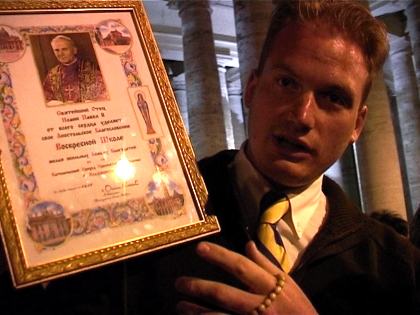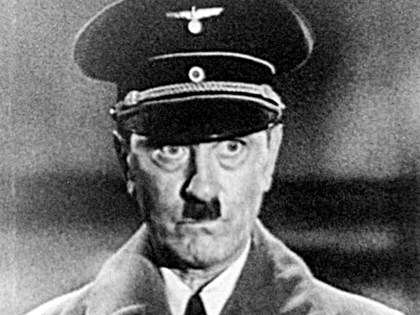Festivals
Venice Film Festival 2011: The S&S blog
Day nine: The sacred and profane

The Flock of the Lord
Barbara Wurm, 9 September
Film of the day
Romuald Karmakar’s documentary The Flock of the Lord (Die Herde des Herrn), a diptych on the Roman Catholic Church and its believers, features among other protagonists a young man who in April 2005 came all the way from Chicago to the Vatican to bid farewell to the deceased Pope John Paul II. Waiting about for up until 12 hours a day, he was hoping was to visit the pope and pray.
“What’s your prayer about?”, Karmakar asks.
“I pray that I can be like Pope John Paul II. I want to be like him. The Catholic Church is number one.”
“Is that important to you – that the Catholic Church is number one?”
“It’s the truth.”
“But why it is important?”
“It’s the truth, and the truth is important. And the truth is that the Catholic Church is number one.”
Obsessed with intellectual precision, Karmakar has, over the years, honed his observational skills into a method that allows an often baffling way of directly confronting the filmed person with questions. It’s by recording and viewing his protagonists’ pronouncements in their totality that Germany’s most fearless filmmaker reveals the sometimes contradictory layers of truth, a truth contained not so much on a logical or verbal level but on a rhetorical one, within intonations and repetitions, contradictions and irrational, emotional and discursive rituals. Die Herde des Herrn seems to unite the two main characteristics of his recent works, the focus on trance, hypnosis, and the masses in his techno trilogy (196 bpm (2003), Between the Devil and the Wide Blue Sea (2005) and Villalobos (2009)) and the provocative ‘talking cure’ in Ramses, his contribution to Deutschland ’09 (2009).
Much of the Venice audience was irritated by the many long, seemingly similar shots of groups of people mourning over the pope’s death on Saint Peter’s Square. But it’s precisely the sometimes minimal deviations that matter, the difference in repetition adding up to a broad overview of subjects’ mentalities. Some pray, others sing. Some weep, others wave flags (in most cases, Poland’s national banner). Some recite the rosary, others make up lyrics. Some are spiritual servants, others masters of pragmatics. Even if they just wait in line endlessly or are about to break down (because they are old or pregnant and have been in the queue for hours) they reveal a determinedness, usually inaccessible to non-believers.
The frenetic yet passionate devotion of the Vatican masses is contrasted with the first part of the film, shot 11 days later on the day Josef Ratzinger was inaugurated Pope Benedictus XVI. In no time at all his birthplace Marktl am Inn turned from a provincial backwater into a centre of worship. The pilgrims are welcomed by proud, business-minded locals, experimenting with marketing concepts such as the ‘pope cap’ (some kind of pastry), the ‘Benedikt XVI herbal tea’ and the famous ‘Marktl pope horse droppings’. Belief is an enterprise, and the church an economic machinery for the constant flow of values (money, emotions, beliefs). It was a good decision to return to this intriguing material, which had lain fallow for more than six years.
Paradise park

Egomania
My day started with a visit to the Biennale Giardini, where Christoph Schlingensief’s widow had resurrected the great artist by turning the ‘Germania’ pavilion into the temple of ‘Egomania’. Icons and statues of the Lord were substituted for a lot of fascinating film clips and examples of set designs from his fantastic oeuvre. Spirituality was in the air, made up of sounds and visuals, visions of horror and trash, of truth and a revealing nakedness.
An equally sad statement on the topics of religion and dying could be found in the exhibition ‘Dmitri Prigov: Dmitri Prigov’ at the Palazzo Foscari, a side event of the Biennale. In his last years this Russian media genius turned to video. Entering the exhibition meant walking right through three screens on which Prigov’s encounters with the big three religions – Islam, Judaism and Christianity – were projected. This oeuvre is full of references to artists, but also full of humour. So it doesn’t come as a surprise that in one drawing installation the person being deconstructed is a famous art student from Braunau (am Inn – just like Marktl), Adolf Hitler.
The many faces of

Conference
Hitler became the object of deconstruction in the last stroke of genius of the day: Norbert Pfaffenbichler’s short experimental Conference, shown with Die Herde des Herrn. The film samples film excerpts of actors playing Adolf Hitler – the figure portrayed more than any other in the history of film – and combines them in a grotesque shot-countershot identity parade. To quote Pfaffenbichler, the most humble and sincere of Austria’s found-footage masters: “Which Hitler is your favourite?”
Day ten: Eccentricities of American college life »
See also
Lourdes reviewed by Michael Brooke (April 2010)
Manhunt reviewed by Tim Lucas (March 2010)
El baño del Papa reviewed by Michael Brooke (August 2008)
Into Great Silence reviewed by Catherine Wheatley (February 2007)
Downfall reviewed by Richard Falcon (May 2005)
The Passion of the Christ reviewed by Mark Kermode (April 2004)
Amen reviewed by Geoffrey Macnab (August 2002)
End of Days reviewed by Mark Kermode (February 2000)
